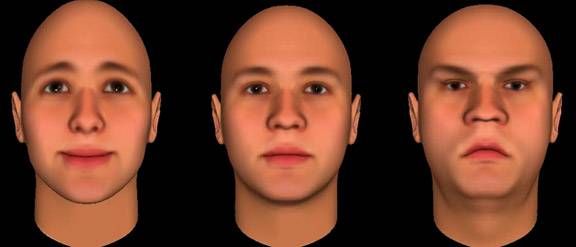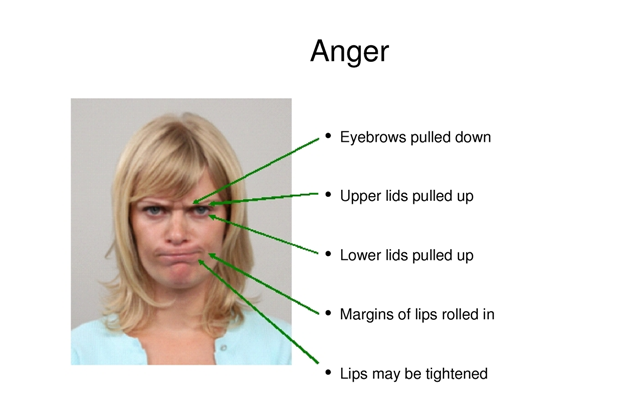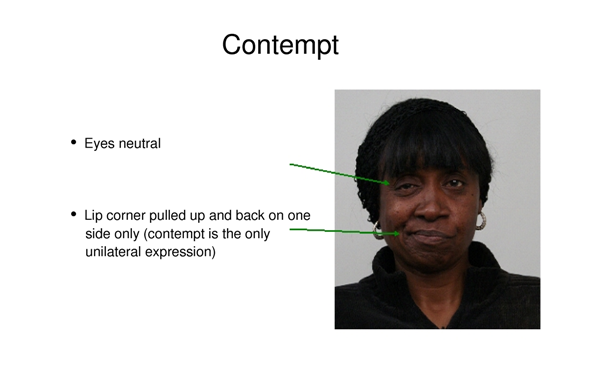A study out of Wellesley University led by Dr. Erik Schlicht investigated “whether an opponent’s face influences players’ wagering decisions in a zero-sum game with hidden information”. In this case, the game they used in their study was Texas Hold’em Poker.
Schlicht and his team asked participants to make “risky” choices while simultaneously being presented with opponents whose faces “differentially correlated with subjective impressions of trust”.
In short, participants were forced to make difficult decisions while seeing a face that was either untrustworthy, neutral or trustworthy.
But what exactly is an untrustworthy or trustworthy face?
According to research out of Princeton University, a trustworthy and untrustworthy face looks like this:

The trustworthy expression seems to have a slight smile and the eyebrows turned slightly up.
By using an expression simliar to the one shown on the above left , Schlicht and his team of researchers found that “threatening face information has little influence on wagering behavior, but faces relaying positive emotional characteristics impact people’s decisions”.
According to the abstract of the study, Schlicht concluded that “the best “poker face” for bluffing may not be a neutral face, but rather a face that contains emotional correlates of trustworthiness”.
The study which was published on July 21, 2010 in PLoS One is titled “Human Wagering Behavior Depends on Opponent’s Faces”.
Facial Expressions and Microexpressions as Poker Tells
Reading tells in poker is as much science as it is art form. While many poker pros will tell you that physical tells mean very little at the highest levels of the games, for the everyday poker player, they can still provide a valuable resource.
There are a few common microexpressions (or facial expression) that you will spot in many lower stakes and inexperienced poker players. Let’s look at a few.
 A common microexpression that can be picked up on is when a player catches a card on the board that makes their hand. If you look carefully their eyes just slightly open wider as to say “that’s it!” (Perhaps an expression of surprise?) It is very brief and if you are not watching them, you will miss it.
A common microexpression that can be picked up on is when a player catches a card on the board that makes their hand. If you look carefully their eyes just slightly open wider as to say “that’s it!” (Perhaps an expression of surprise?) It is very brief and if you are not watching them, you will miss it.
Something that goes in tandem with this microexpression is that the player may either look instinctively at their chips or may quickly glance at you. However, for those that just continue to stare ahead, the slight “bingo look” will give them away.
 Adversely, another tell similar to the “bingo look” is when a player misses their intended card on the board. Let’s assume they are drawing to a straight or a flush and their draw fails to get there. When the river card hits, they might ever so slightly squint or slightly frown their brow.
Adversely, another tell similar to the “bingo look” is when a player misses their intended card on the board. Let’s assume they are drawing to a straight or a flush and their draw fails to get there. When the river card hits, they might ever so slightly squint or slightly frown their brow.
Another variation could be a hard blink that is noticeably different and in some cases may be hard enough to make them nod a bit. This is many times a clear indication that they missed their draw and are disappointed in the result.
 One final expression is commonly seen in conjunction with bluffing. The river card comes and as the player bets, they let an ever so slight smirk.
One final expression is commonly seen in conjunction with bluffing. The river card comes and as the player bets, they let an ever so slight smirk.
Chances are that they are bluffing. Some people when they lie will give off a slight smile like they are getting away with something.
Keep in mind that the above microexpression tells are best used at lower limits and against truly inexperienced players. Those types of players are not taking poker games seriously and are not truly worried over profits.
As you come across more experienced players, they will tend to not exhibit these traits as frequently, and if they do, you then have to figure out whether they are using them to try and fool you.